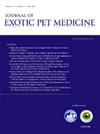Mycobacteriosis in the swim bladder caused by Mycobacterium fortuitum in a blood parrot cichlid (Amphilophus citrinellus × Paraneetroplus synspilus)
IF 0.6
4区 农林科学
Q4 VETERINARY SCIENCES
引用次数: 0
Abstract
Background
Swim bladder disorders occur frequently in several fish species, with bacterial infections being a primary cause. However, infections caused by mycobacteria are not usually reported.
Case description
A blood parrot cichlid (Amphilophus citrinellus × Paraneetroplus synspilus) presented with a recurrent unresponsive swim bladder disorder. The fish had undergone several unsuccessful aspirations of the swim bladder and antimicrobial treatments. Ultrasonography and radiography indicated fluid accumulation in the swim bladder. A turbid-yellowish fluid containing numerous acid-fast–positive bacilli was obtained during swim bladder aspiration. The fish was subsequently euthanized, and the necropsy revealed a fluid-filled enlarged swim bladder with yellowish sediments. Histopathological examination using Ziehl–Neelsen staining identified multiple granulomas encapsulating acid-fast–positive bacilli in several internal organs. Mycobacterium fortuitum infection was confirmed through polymerase chain reaction assay and genetic analysis.
Conclusion and case relevance
This primary report documents the unusual pathology of M. fortuitum infection in this particular cichlid species, in which the bacteria colonized the swim bladder cavity, leading to a buoyancy disorder.
一种血鹦鹉慈鲷(Amphilophus citrinellus × Paraneetroplus synspilus)的膀胱分枝杆菌病由 fortuitum 分枝杆菌引起
背景多种鱼类经常出现膀胱疾病,细菌感染是主要原因。病例描述一条血鹦鹉鱼(Amphilophus citrinellus × Paraneetroplus synspilus)反复出现反应迟钝的膀胱疾病。该鱼曾多次接受膀胱抽吸和抗菌治疗,但均未成功。超声波检查和放射线检查显示鱼鳔内有积液。在抽吸鱼鳔时,发现鱼鳔内有浑浊的淡黄色液体,其中含有大量酸性革兰氏阳性杆菌。随后对该鱼实施了安乐术,尸体解剖结果显示,鱼鳔内充满了液体,并伴有淡黄色沉淀物。使用齐氏-奈尔森染色法进行的组织病理学检查在多个内脏器官中发现了包裹酸性-耐斯特阳性杆菌的多个肉芽肿。通过聚合酶链式反应检测和基因分析,确认了福氏分枝杆菌感染。结论和案例相关性这篇主要报告记录了福氏分枝杆菌感染这种特殊慈鲷的不寻常病理过程,细菌在鳔腔内定植,导致浮力失调。
本文章由计算机程序翻译,如有差异,请以英文原文为准。
求助全文
约1分钟内获得全文
求助全文
来源期刊

Journal of Exotic Pet Medicine
农林科学-兽医学
CiteScore
1.20
自引率
0.00%
发文量
65
审稿时长
60 days
期刊介绍:
The Journal of Exotic Pet Medicine provides clinicians with a convenient, comprehensive, "must have" resource to enhance and elevate their expertise with exotic pet medicine. Each issue contains wide ranging peer-reviewed articles that cover many of the current and novel topics important to clinicians caring for exotic pets. Diagnostic challenges, consensus articles and selected review articles are also included to help keep veterinarians up to date on issues affecting their practice. In addition, the Journal of Exotic Pet Medicine serves as the official publication of both the Association of Exotic Mammal Veterinarians (AEMV) and the European Association of Avian Veterinarians (EAAV). The Journal of Exotic Pet Medicine is the most complete resource for practitioners who treat exotic pets.
 求助内容:
求助内容: 应助结果提醒方式:
应助结果提醒方式:


